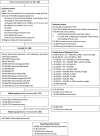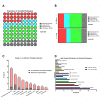Epidemiology of community-acquired pneumonia among hospitalised children in Indonesia: a multicentre, prospective study
- PMID: 35728910
- PMCID: PMC9214401
- DOI: 10.1136/bmjopen-2021-057957
Epidemiology of community-acquired pneumonia among hospitalised children in Indonesia: a multicentre, prospective study
Abstract
Objective: To identify aetiologies of childhood community-acquired pneumonia (CAP) based on a comprehensive diagnostic approach.
Design: 'Partnerships for Enhanced Engagement in Research-Pneumonia in Paediatrics (PEER-PePPeS)' study was an observational prospective cohort study conducted from July 2017 to September 2019.
Setting: Government referral teaching hospitals and satellite sites in three cities in Indonesia: Semarang, Yogyakarta and Tangerang.
Participants: Hospitalised children aged 2-59 months who met the criteria for pneumonia were eligible. Children were excluded if they had been hospitalised for >24 hours; had malignancy or history of malignancy; a history of long-term (>2 months) steroid therapy, or conditions that might interfere with compliance with study procedures.
Main outcomes measures: Causative bacterial, viral or mixed pathogen(s) for pneumonia were determined using microbiological, molecular and serological tests from routinely collected specimens (blood, sputum and nasopharyngeal swabs). We applied a previously published algorithm (PEER-PePPeS rules) to determine the causative pathogen(s).
Results: 188 subjects were enrolled. Based on our algorithm, 48 (25.5%) had a bacterial infection, 31 (16.5%) had a viral infection, 76 (40.4%) had mixed bacterial and viral infections, and 33 (17.6%) were unable to be classified. The five most common causative pathogens identified were Haemophilus influenzae non-type B (N=73, 38.8%), respiratory syncytial virus (RSV) (N=51, 27.1%), Klebsiella pneumoniae (N=43, 22.9%), Streptococcus pneumoniae (N=29, 15.4%) and Influenza virus (N=25, 13.3%). RSV and influenza virus diagnoses were highly associated with Indonesia's rainy season (November-March). The PCR assays on induced sputum (IS) specimens captured most of the pathogens identified in this study.
Conclusions: Our study found that H. influenzae non-type B and RSV were the most frequently identified pathogens causing hospitalised CAP among Indonesian children aged 2-59 months old. Our study also highlights the importance of PCR for diagnosis and by extension, appropriate use of antimicrobials.
Trail registration number: NCT03366454.
Keywords: epidemiology; infectious diseases; paediatrics.
© Author(s) (or their employer(s)) 2022. Re-use permitted under CC BY. Published by BMJ.
Conflict of interest statement
Competing interests: None declared.
Figures



References
Publication types
MeSH terms
Associated data
Grants and funding
LinkOut - more resources
Full Text Sources
Medical
Miscellaneous
